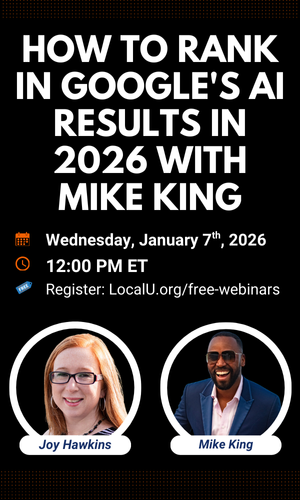Linda Buquet
Member
- Joined
- Jun 28, 2012
- Messages
- 13,313
- Reaction score
- 4,148
<img src="http://marketing-blog.catalystemarketing.com/wp-content/uploads/2012/06/poke.jpg" alt="" title="poke" width="200" align="left" hspace="6" /> <strong>How do you POKE a Place page?
Why should you poke it?
What type of problems can a poke solve?
How often should you POKE it?</strong>
(See tech Google support emails below.)
This post will be remedial for some of the Google Local pros - but I'm amazed at how many companies I do G+ Local training for that don't know about this trick.
In my Advanced training I refer to a POKE as your new 2nd best friend!
Many companies I train work on Place pages daily, but their core focus is more on SEO or building vertical turn-key sites and Places is just a value-add service they offer. So they don't have a 100% Places focus and therefore don't know some of the tricks of the trade, like how to poke, why to poke and when to poke. I'd say about 65% of my training clients don't know what a Poke is and most that come to me for training are pretty serious professionals, so that tells me lots of my other readers especially business owners, likely don't know what a poke is either.
<strong>WHAT IS A POKE?</strong> A poke is technically called a "null edit". I think of it like rebooting a computer when it gets slow or buggy. Sometimes it just fixes it for some mysterious reason. A poke won't fix every type of problem - but it's a quick, easy, non-invasive troubleshooting step, you need in your tool box.
<strong>WHY POKE?</strong> What the poke really does on the back end, is send a signal to Google that this listing is actively managed and the data in this dashboard should take precedence. Now that does not mean it always will. Remember when Google started sending those emails saying - warning your info is about to change? The way they told you to suppress the change was to do a null edit.
Also if there are multiple owners of a listing like: the secretary you fired created a listing too with some funky address formatting and you can't get the log in, so your address keeps changing to the bad format. Well in cases like that, the last submit wins. So a poke tells Google to pay attention to the data in YOUR dashboard instead of hers.
<strong>WHAT PROBLEMS CAN A POKE HELP?</strong> When something is a little buggy on a listing - like the address on live Place page does not match what's in dash or categories are off. I've even seen Google recommend a poke to snap a listing back from pending review if it's compliant, but just stuck. AGAIN it does not work for everything but it's a quick, easy, non-invasive troubleshooting step.
<strong>HOW TO POKE</strong> - Poking is easy. Log in - click edit, DON'T CHANGE ANYTHING, then hit submit. Pokes used to be pretty much instant, so if you poked you could tell right away if it fixed the problem. However with the current back end dataflow, it can take a few days before you know if the poke worked. So poke, wait 4 days and if still problems, use the troubleshooter.
<strong>HOW OFTEN TO POKE</strong> - <strong>Google support is now telling users in problem follow-up emails to poke on a regular basis.</strong> (See support emails below.) I see some guys on the forum that have missing listings due to all the service area business problems that say they are poking their listing several times a day. Bad move and overkill, I say! <strong>I recommend poking once a month, even on normal healthy listings, which I think is a proactive step that could prevent problems like Google changing the address on you.</strong>
Snippets below from 3 different support emails that recommend "regular pokes."
Have you poked your listing lately???</strong>
Image credit: <a href="http://www.flickr.com/photos/noodle93/4162849840/">Tom Newby Photography</a>
Why should you poke it?
What type of problems can a poke solve?
How often should you POKE it?</strong>
(See tech Google support emails below.)
This post will be remedial for some of the Google Local pros - but I'm amazed at how many companies I do G+ Local training for that don't know about this trick.
In my Advanced training I refer to a POKE as your new 2nd best friend!
Many companies I train work on Place pages daily, but their core focus is more on SEO or building vertical turn-key sites and Places is just a value-add service they offer. So they don't have a 100% Places focus and therefore don't know some of the tricks of the trade, like how to poke, why to poke and when to poke. I'd say about 65% of my training clients don't know what a Poke is and most that come to me for training are pretty serious professionals, so that tells me lots of my other readers especially business owners, likely don't know what a poke is either.
<strong>WHAT IS A POKE?</strong> A poke is technically called a "null edit". I think of it like rebooting a computer when it gets slow or buggy. Sometimes it just fixes it for some mysterious reason. A poke won't fix every type of problem - but it's a quick, easy, non-invasive troubleshooting step, you need in your tool box.
<strong>WHY POKE?</strong> What the poke really does on the back end, is send a signal to Google that this listing is actively managed and the data in this dashboard should take precedence. Now that does not mean it always will. Remember when Google started sending those emails saying - warning your info is about to change? The way they told you to suppress the change was to do a null edit.
Also if there are multiple owners of a listing like: the secretary you fired created a listing too with some funky address formatting and you can't get the log in, so your address keeps changing to the bad format. Well in cases like that, the last submit wins. So a poke tells Google to pay attention to the data in YOUR dashboard instead of hers.
<strong>WHAT PROBLEMS CAN A POKE HELP?</strong> When something is a little buggy on a listing - like the address on live Place page does not match what's in dash or categories are off. I've even seen Google recommend a poke to snap a listing back from pending review if it's compliant, but just stuck. AGAIN it does not work for everything but it's a quick, easy, non-invasive troubleshooting step.
<strong>HOW TO POKE</strong> - Poking is easy. Log in - click edit, DON'T CHANGE ANYTHING, then hit submit. Pokes used to be pretty much instant, so if you poked you could tell right away if it fixed the problem. However with the current back end dataflow, it can take a few days before you know if the poke worked. So poke, wait 4 days and if still problems, use the troubleshooter.
<strong>HOW OFTEN TO POKE</strong> - <strong>Google support is now telling users in problem follow-up emails to poke on a regular basis.</strong> (See support emails below.) I see some guys on the forum that have missing listings due to all the service area business problems that say they are poking their listing several times a day. Bad move and overkill, I say! <strong>I recommend poking once a month, even on normal healthy listings, which I think is a proactive step that could prevent problems like Google changing the address on you.</strong>
Snippets below from 3 different support emails that recommend "regular pokes."
<strong>What do you think? Did you know all about pokes?(This one was in reply to a missing listing G was trying to revive)
"To ensure that your listings contain the most accurate information possible please continue to freshen the data on your listing from your account by clicking “Edit” from your dashboard, then clicking “Submit” to send your information to Google Maps on a regular basis"
(This one in reply to a partial merge)
"Please continue to update your listing from your account by clicking "Edit" from your dashboard, then clicking "Submit" to send your information to Google Maps. Doing this regularly will ensure that your listings contain the most accurate information possible."
(This one I believe was in reply to a pending review)
“If you sign into your Places account, click “Edit” on the affected listing, and then click “Submit”. Within a few days, your listing should show as “Active” from your account and link to your live listing on Maps.”
Have you poked your listing lately???</strong>
Image credit: <a href="http://www.flickr.com/photos/noodle93/4162849840/">Tom Newby Photography</a>




